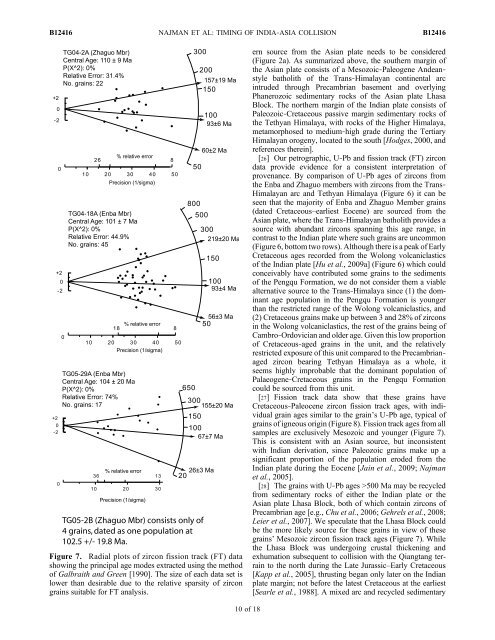Timing of IndiaâAsia collision: Geological, biostratigraphic, and ...
Timing of IndiaâAsia collision: Geological, biostratigraphic, and ...
Timing of IndiaâAsia collision: Geological, biostratigraphic, and ...
You also want an ePaper? Increase the reach of your titles
YUMPU automatically turns print PDFs into web optimized ePapers that Google loves.
B12416<br />
NAJMAN ET AL: TIMING OF INDIA‐ASIA COLLISION<br />
B12416<br />
Figure 7. Radial plots <strong>of</strong> zircon fission track (FT) data<br />
showing the principal age modes extracted using the method<br />
<strong>of</strong> Galbraith <strong>and</strong> Green [1990]. The size <strong>of</strong> each data set is<br />
lower than desirable due to the relative sparsity <strong>of</strong> zircon<br />
grains suitable for FT analysis.<br />
ern source from the Asian plate needs to be considered<br />
(Figure 2a). As summarized above, the southern margin <strong>of</strong><br />
the Asian plate consists <strong>of</strong> a Mesozoic‐Paleogene Andeanstyle<br />
batholith <strong>of</strong> the Trans‐Himalayan continental arc<br />
intruded through Precambrian basement <strong>and</strong> overlying<br />
Phanerozoic sedimentary rocks <strong>of</strong> the Asian plate Lhasa<br />
Block. The northern margin <strong>of</strong> the Indian plate consists <strong>of</strong><br />
Paleozoic‐Cretaceous passive margin sedimentary rocks <strong>of</strong><br />
the Tethyan Himalaya, with rocks <strong>of</strong> the Higher Himalaya,<br />
metamorphosed to medium‐high grade during the Tertiary<br />
Himalayan orogeny, located to the south [Hodges, 2000, <strong>and</strong><br />
references therein].<br />
[26] Our petrographic, U‐Pb <strong>and</strong> fission track (FT) zircon<br />
data provide evidence for a consistent interpretation <strong>of</strong><br />
provenance. By comparison <strong>of</strong> U‐Pb ages <strong>of</strong> zircons from<br />
the Enba <strong>and</strong> Zhaguo members with zircons from the Trans‐<br />
Himalayan arc <strong>and</strong> Tethyan Himalaya (Figure 6) it can be<br />
seen that the majority <strong>of</strong> Enba <strong>and</strong> Zhaguo Member grains<br />
(dated Cretaceous–earliest Eocene) are sourced from the<br />
Asian plate, where the Trans‐Himalayan batholith provides a<br />
source with abundant zircons spanning this age range, in<br />
contrast to the Indian plate where such grains are uncommon<br />
(Figure 6, bottom two rows). Although there is a peak <strong>of</strong> Early<br />
Cretaceous ages recorded from the Wolong volcaniclastics<br />
<strong>of</strong> the Indian plate [Hu et al., 2009a] (Figure 6) which could<br />
conceivably have contributed some grains to the sediments<br />
<strong>of</strong> the Pengqu Formation, we do not consider them a viable<br />
alternative source to the Trans‐Himalaya since (1) the dominant<br />
age population in the Pengqu Formation is younger<br />
than the restricted range <strong>of</strong> the Wolong volcaniclastics, <strong>and</strong><br />
(2) Cretaceous grains make up between 3 <strong>and</strong> 28% <strong>of</strong> zircons<br />
in the Wolong volcaniclastics, the rest <strong>of</strong> the grains being <strong>of</strong><br />
Cambro‐Ordovician <strong>and</strong> older age. Given this low proportion<br />
<strong>of</strong> Cretaceous‐aged grains in the unit, <strong>and</strong> the relatively<br />
restricted exposure <strong>of</strong> this unit compared to the Precambrianaged<br />
zircon bearing Tethyan Himalaya as a whole, it<br />
seems highly improbable that the dominant population <strong>of</strong><br />
Palaeogene‐Cretaceous grains in the Pengqu Formation<br />
could be sourced from this unit.<br />
[27] Fission track data show that these grains have<br />
Cretaceous‐Paleocene zircon fission track ages, with individual<br />
grain ages similar to the grain’s U‐Pb age, typical <strong>of</strong><br />
grains <strong>of</strong> igneous origin (Figure 8). Fission track ages from all<br />
samples are exclusively Mesozoic <strong>and</strong> younger (Figure 7).<br />
This is consistent with an Asian source, but inconsistent<br />
with Indian derivation, since Paleozoic grains make up a<br />
significant proportion <strong>of</strong> the population eroded from the<br />
Indian plate during the Eocene [Jain et al., 2009; Najman<br />
et al., 2005].<br />
[28] The grains with U‐Pb ages >500 Ma may be recycled<br />
from sedimentary rocks <strong>of</strong> either the Indian plate or the<br />
Asian plate Lhasa Block, both <strong>of</strong> which contain zircons <strong>of</strong><br />
Precambrian age [e.g., Chu et al., 2006; Gehrels et al., 2008;<br />
Leier et al., 2007]. We speculate that the Lhasa Block could<br />
be the more likely source for these grains in view <strong>of</strong> these<br />
grains’ Mesozoic zircon fission track ages (Figure 7). While<br />
the Lhasa Block was undergoing crustal thickening <strong>and</strong><br />
exhumation subsequent to <strong>collision</strong> with the Qiangtang terrain<br />
to the north during the Late Jurassic–Early Cretaceous<br />
[Kapp et al., 2005], thrusting began only later on the Indian<br />
plate margin; not before the latest Cretaceous at the earliest<br />
[Searle et al., 1988]. A mixed arc <strong>and</strong> recycled sedimentary<br />
10 <strong>of</strong> 18

















